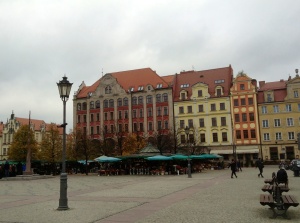I have noticed that Poland is a nation that has both a Western and an Eastern face. Over centuries, this part of the world was a tug of war between the East and West. After WW II, under Russian influence, it took an Eastern turn. You can see it in the buildings, not the simple box-like structures the Communists built to replace destroyed buildings after the war–and it looks like the Polish authorities are revamping those buildings to look Polish–but in the old buildings, the ones that could be in Germany, except the woodwork and turrets are different, and the colors are more pastel. They have an Eastern flavor. (A bit of history–this area is known as Silesia, a battleground over centuries, as Austria, Poland, and Prussia fought over it. Eventually, it was Germany for centuries, and mainly Lutheran. After WW II, the Russians gave it to Poland, as an outcome of the Potsdam Agreement, in exchange for annexing part of Poland into Russia. Overnight, Germans were forced out, and displaced Poles were transported in. Lutheran churches became Roman Catholic and, under Russian domination, Poland took an Eastern turn.)

Interior of the Church of the Most Holy Name of Jesus, Wroclaw, Poland, miraculously avoided destruction during World War II.
Today, we ate amazing food. Yes, we got the wonderful lard spread with roasted garlic again, along with great sour dill pickles and cabbage salad fixed three ways; but, pierogi were the star. They are delectable dough pockets filled with cottage cheese, potatoes and onion, boiled and covered with onions sautéed in bacon fat–need I say more! I wanted more, but nine huge ones seemed like the place I should stop! I consoled myself with the thought that we go to Krakow in east Poland for several days–more of an Eastern turn–and I can “fill-er-up” there. Oh, I forgot to mention the hot chocolate so thick, you ate it with a spoon, covered with real whipped cream and dark chocolate curls. Are you hungry yet? WEG






